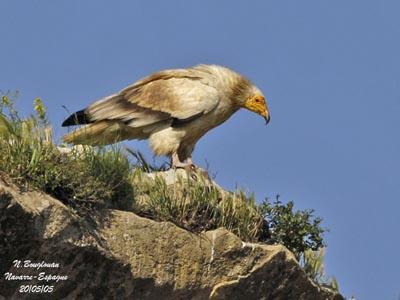
Egyptian Vulture
(Neophron percnopterus)
Accipitriforme Order – Accipitridae Family

Orally transmitted since centuries, these legends make obvious its statute of sacred bird. One of them mentions the Phoenix Bird’s myth which set fire to itself for better returning, rising from its ashes. Transformed with the passing centuries, it is in the Canary Islands where this vulture is still present that one finds his trace, ensuring that when this bird feels death, it rises to the sky and disappears in the airs… Let us not allow it to fly away so far, and make the most of its presence as long as it is offered to us!
The first time that I saw this vulture, it was flying above a dump, its favourite pantry! I believed to see a White Stork. But in my mind, there was something wrong… the legs did not exceed behind the tail, not long neck, not long bill! Then, I raised again my eyes and I admired it, flying slowly contrasting against the blue sky, quite wonderful and majestic! Another vulture came to join it, and then still another, and they mixed with the other birds already present. The show did nothing but to start…
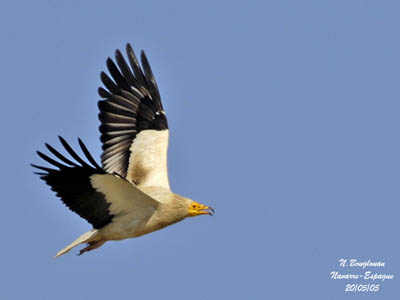
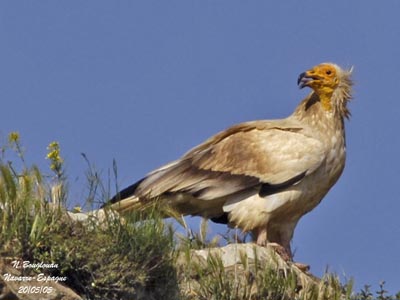
Its white plumage contrasts with the black wing tips. The brownish shades on neck, chest and back give some relief to this whole steeped in quiet force. The Egyptian Vulture is perhaps smaller than its congenerics, but it is not less one beautiful, smart and useful raptor.
Rather quiet bird, it utters sometimes an accelerated rolling call during the flight displays. These aerial behaviours are wonderful. Parallel flights, in line, side by side ends of the wings almost touching, aerobatics, dives, glides, turning over in flight in order to present the talons to the partner. It is the apotheosis of its art! This raptor which seems to be slow and clumsy in some typical phases of flight breaks out during its love’s exhibitions.
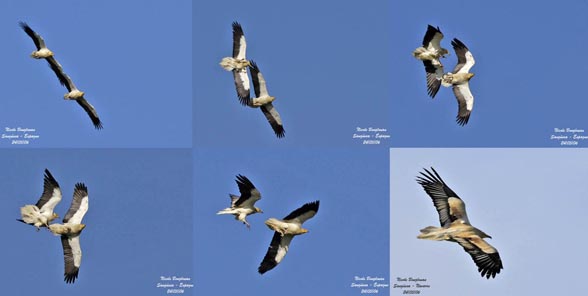
The Egyptian Vulture fits out its nest in a rocky cavity under overhanging rock which protects it. He lives in the mountainous areas whit cliffs, but flies over open lands for hunting and feeding. It is important that the nest-site be located close to a river valley where the cattle will graze, because it is part of its food resources. The nest is summary. Some dry shrub branches and bits of wood, added to malodorous bones and various “remains” constitute the nest, lined with wool. The two adults bring the materials of this true garbage dump!
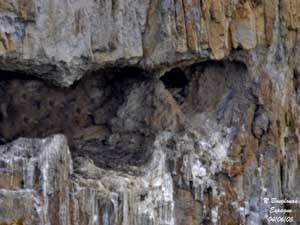
Two whitish eggs spotted with brown are laid in this place, and hatch 42 days later. Covered with white down, the chicks have distinct sizes, and very often, the weakest dies, giving all the chances to the elder. The chick is brooded by its mother several times per day. It is fed with pieces of meat torn off the preys brought to the nest.
When the plumage is growth, the young remains near the nest where it is fed by both adults. During the day, it takes sunbathes with half-opened wings.
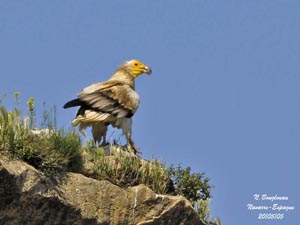
This vulture feeds on carcasses, wastes, carrions, and numerous other items, from frogs, small reptiles and insects, to eggs, fruits, and faeces left by the cattle on pastures. It rids of parasites the cows, removing the ticks which infested their natural orifices and all happening quietly when the animal is lying! In front of a carcass, the Egyptian Vulture will leave initially the place to the ravens which devour the softer parts. Then, it takes its turn. It tears the abdomen in order to feed on the entrails.
Several individuals are settled in the vicinity, waiting for their turn. There is a hierarchy, based on the age of the bird, the young feed after the adults. Sometimes, it is possible to see a yellow skin projection on the breast. This projection could indicate to the other present vultures that this one is satisfied. The full and inflated jabot draws aside the feathers, making appear a ball of naked skin. That would also fall into their way to approach the food in a certain order.
The Egyptian Vulture belongs to the animals which are able to use tools. In some areas of Africa where the ostrich’s eggs are part of its diet, it has to use a stratagem for consuming them. Its too fine bill does not allow him to break the thick shell. It takes a stone between its mandibles, and throws it on the egg. It will make it again until the shell be cracked, and being able to insert the bill into the slit for eating the interior.
The Egyptian Vulture is migratory, and the movements towards the South of the Sahara start in late August, reaching their stronger intensity in September. Whatever he lives in Europe, Near East or North Africa, it will leave towards its wintering areas and return in February-March. It passes by Gibraltar and the Bosphorus, and the show is amazing every time! It occurs in a clearly Mediterranean area during the reproduction, but in Europe, it extends towards Balkans, under the Danube and the Crimea.
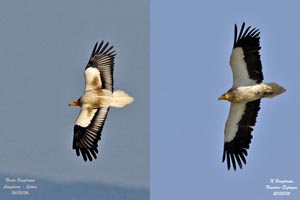
The young which leave the territory migrate southwards, and will come back only a few years later to their native area, when they reached their sexual maturity for breeding, in four or five years. They will have at this moment the black and white adult plumage, after various stages of colouring, from the darkest at the beginning, through white-brown, and finally becoming similar to their parents.
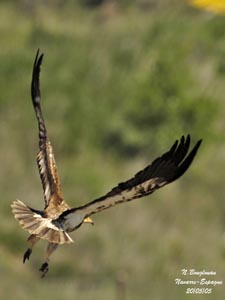
This small vulture lives in mountainous areas where the cliffs offer suitable cavities for the nest. However, it hunts and feeds in open areas. The adults live in pairs, but fairly apart from each other because they are not very sociable. The Egyptian Vultures gather at roosts in the evening, on coastal or interior cliffs. One can distinguish three distinct zones in these concentrations. The first is the roost, the second is a place where the birds can take the heat of the sun, and finally the third is a place where they feed, bringing some preys there. A few tens of individuals, both immature and adult may gather at these roosts.
The Egyptian Vulture cannot be confused with any other bird of prey. By far, it resembles a white stork, but when it approaches, its broad rectangular wings, its wedge-shaped tail, its small head with yellow face and the slender, hooked bill make it unique.
Rarer than other species quite as beautiful, it is the living symbol of this Phoenix Bird which disappeared for better returning. Let us simply hope that he will not abandon our mountains and he will return there each year. It is vulnerable due to its small populations. In Spain, France, Greece and Turkey, it was voluntarily poisoned by the farmers who believed, wrongly, that it was carrying vermin.
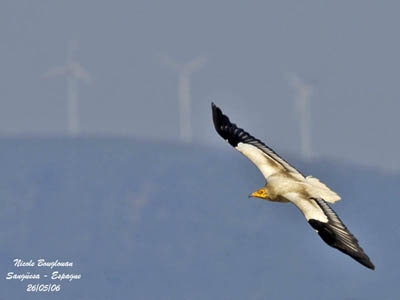
Particularly venerated in ancient Egypt, the Egyptian Vulture is one of the most beautiful jewels of our Pyrenees. Its role of “scavenger” was worth the sympathy of a Pharaoh who punished of dead whoever killed one of these birds. These facts gave him the name of “Pharaoh’s child”. Such historical honour is worth some consideration isn’t it?
Text and photographs by Nicole Bouglouan
Another link: Old World Vultures
Sources :
THE HANDBOOK OF BIRD IDENTIFICATION FOR EUROPE AND THE WESTERN PALEARCTIC by Mark Beaman, Steve Madge - C.Helm - ISBN: 0713639601
GUIDE DES RAPACES DIURNES – Europe, Afrique du Nord et Moyen-Orient de Benny Génsbol – Delachaux et Niestlé – ISBN : 2603013270
Animal Diversity Web - (University of Michigan Museum of Zoology)
Wikipedia (Wikipedia, The Free Encyclopedia)